

Sarthak
By Sarthak, a data analyst at Fischer Jordan, with an interest in data science and emerging tech solutions for business analytics and Malavika, an intern at Fischer Jordan, working on solving strategic business problems for clients across industries.

Malavika
Diversity in workplace refers to the presence of individual differences among employees, including but not limited to race, ethnicity, gender, age, sexual orientation, religion, disability, and cultural background[1]. One may develop an environment that embraces and celebrates diversity by recognizing, respecting, and appreciating these differences. In her book “Managing Workplace Diversity, Equity, and Inclusion: A Psychological Perspective,”[2] Rosemary Hayes-Thomas defined diversity as having two fundamental scales: broad and narrow.
When the concept of diversity and the word itself first gained popularity in the 1980s, it was used to describe changes in the racial, ethnic, and sexual composition of the labor force and workplace groups. This line of thinking is what she called narrow diversity. Soon, practitioners and researchers began to see a pattern: women and ethnic minorities were indeed hired, but they seldom progressed in the organization, and some even left in a fairly short time. Merely hiring people from underrepresented groups was clearly not sufficient to maintain diversity[3]. Considering other bases for diversity, such as education level, geographic background, language, value system, and other attributes, came to be understood as the broader meaning of diversity.
Inclusion is something very commonly used with the word diversity in today’s time. Creating an environment where every single individual feels valued, respected, and included as well as one where their viewpoints and experiences are taken into account and accepted is referred to as inclusion. Most people don’t realize that it goes beyond diversity to actively promote equitable chances, guaranteeing that everyone has access to resources and is given the same opportunity to participate in and make decisions. Inclusive practices aim to eliminate prejudices, impediments, and systematic disparities so that everyone can achieve their full potential and contribute[4].
Diversity and Inclusion (D&I) policies are that set of norms and practices aimed at creating a diverse and inclusive work environment and going beyond mere representation. It focuses on harboring an inclusive culture where every individual feels welcome, valued, and supported[5]. When employers consider factors that lead people of difference to become fully accepted and equally productive and rewarded at work, this state is called inclusion. But even when we try to achieve this, it tends to create its own set of negative impacts.
At a global level, studies have shown that D&I policies positively impact profitability of organizations. Higher competitiveness, employee retention and productivity[6] are also seen. A diverse workforce brings people with different backgrounds, experiences and outlooks together. It encourages them to come up with innovative ideas that help solve complex problems and create new products or services[7]. Diverse teams can make better decisions since they consider a broader range of viewpoints. This can lead to better strategic planning, risk management, and problem-solving. A meta-analysis of 108 studies found a positive correlation between diversity and organizational performance, with teams that were diverse out-performing homogeneous teams[8]. In addition to its effects on organizational outcomes, diversity in workplace also impacts employee experience, motivation and engagement[9] levels. For example, diverse workplaces had higher job satisfaction[10] and employees in such work environments had higher levels of commitment and organizational citizenship behavior[11].
Despite these positive effects, not all studies have found diversity to be a consistent predictor of organizational outcomes and diversity can also lead to negative experiences for employees. For example, diversity can lead to conflicts and decrease satisfaction in work groups, particularly if group members have differing values and beliefs[12]. Employees in diverse work environments also reported higher levels of perceived discrimination and harassment[13]. Studies have also found that employees in diverse work environments report feeling less connected to their colleagues than employees in homogeneous work environments[14].
Though we see these negatives, it would be safe to say that employee diversity has a significant positive impact on organizational performance[15]. But it only impacts performance positively when appropriately managed; when employees feel that their differences are valued, they are more likely to be engaged and dedicated to their work[16]. Effectively managing diversity in the workplace involves harnessing and respecting the cultural distinctions in employees’ skills, ideas, and creativity, encouraging them to contribute to a shared objective in a manner that gives organizations a competitive advantage[17].
Our Study:
In our exploration, we focused on understanding the impact (if any) that these policies implemented by companies have on their employees. This study focuses on gender diversity due to the significance of such policies in the Indian job market. Though concentrating on gender would mean going back to Rosemary Hayes-Thomas’s narrow definition of diversity, it is a decent starting point. Our study examined how these policies affected retention, productivity, and employee satisfaction.
The starting point for building a diverse workforce is indeed recruitment. As a recruiter, you would want to hire ‘The Best’ for your company. But what if you’re facing a ‘diversity’ problem in your firm? Then you would try to rectify that by hiring from the minority. However, doesn’t that affect the first goal? Anecdotally, we have seen that as an ongoing trend, companies, even MNCs, coming to Indian campuses for recruitment, often follow a ‘Diversity Hiring Policy’ to increase the number of women in their workplace. Some examples include Uber, Google, Microsoft, PayPal and Adobe. However, it is unclear if these policies come with a cost. Hence, we also decided to ask the following questions related to policies aimed at hiring more women:
- Is this positively impacting women as intended?
- Is there a negative impact on other genders?
- Is there a negative impact on the ability to hire high performers?
Methodology
In our study, we conducted two surveys:
- The first survey focused on getting responses from the current employees working in various companies across 5 main industries (IT, Pharmaceuticals, Automobile, Banking & Financial Services and FMCG).
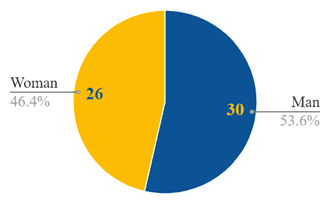
- The second survey focused on the current and recently graduated students from various Indian colleges, who are either sitting for placements, or are now working after receiving job-offers through the placement process.
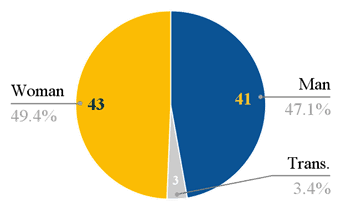
For this survey, we created 4 fictitious companies[18]
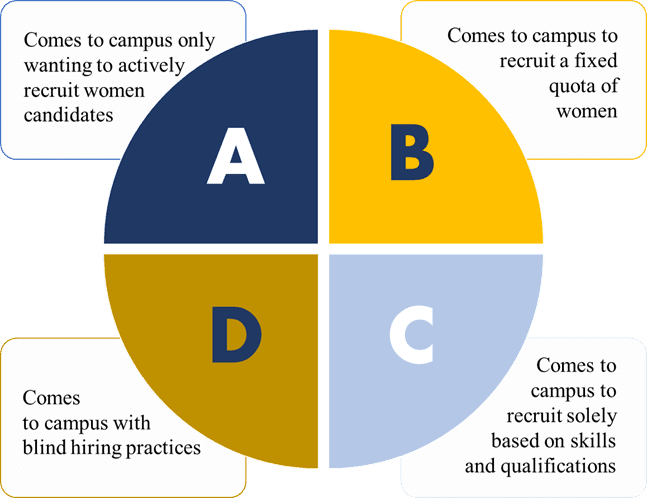
To study the behavior of high-performing candidates, we had asked questions relating to academic, leadership and extracurricular activities, and indexed them, since most companies look for a variety of these skills, when going through CVs and shortlisting candidates. After applying our performance based parameters and calculating a cumulative score, we understood that this was the distribution of the respondents based on their performance.
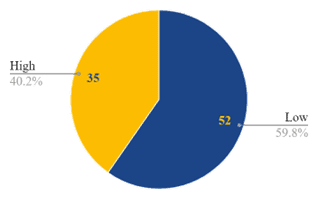
Analysis
- Insight #1
Maintaining strong D&I policies and a diverse environment are key drivers in satisfaction and retention of women. D&I policies also have a positive impact on productivity for men and women. It seems that diversity begets diversity i.e., to retain women, companies need to have strong diversity policies and maintain a diverse environment.
1: Strongly Disagree
5: Strongly Agree Are D&I policies/levels a primary factor in my willingness to continue working in any company.1: Strongly Disagree
5: Strongly Agree Rating for the impact of diversity and inclusion policies on productivity at work1: Strongly Decreases
5: Strongly Increases
- Insight #2
Women do not find exclusive women hiring policies attractive, but they did have a preference to the fixed quotas for women[19].
Willingness to Join Score (average)
1= Low, 4= High
# of Respondents = 43 [Women only]
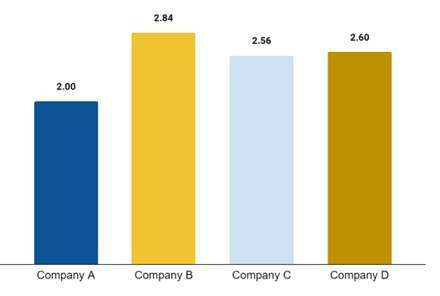
- Insight #3
Men have a clear preference for policies that do not introduce any potential bias[20], but men did not find them completely unfair.
Willingness to Join Score (average)
1= Low, 4= High
# of Respondents = 41 [Men only]
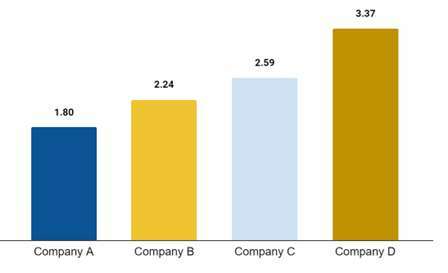
Do you think this kind of diversity hiring policy is unfair to you? (average)
1=Strongly Disagree; 5=Strongly Agree
| Gender | # Respondents | AVERAGE of D/A[21] Unfair (A) | AVERAGE of D/A Unfair (B) | AVERAGE of D/A Unfair (C) | AVERAGE of D/A Unfair (D) |
| Man | 41 | 2.9 | 2.9 | 2.4 | 2.4 |
| Transgender | 3 | 3.0 | 2.0 | 1.7 | 2.0 |
| Woman | 43 | 1.8 | 2.5 | 2.7 | 1.7 |
| Grand Total | 87 | 2.4 | 2.7 | 2.5 | 2.1 |
Even though men feel that the hiring policy of company C & D are equally fair, they still prefer Company D. This proves our hypothesis that was made anecdotally, that even in a supposed fair process for hiring, men feel at a disadvantage compared to women.
- Insight #4
Transgenders also have a strong preference against exclusive hiring for women.[22]
Willingness to Join Score (average)
1= Low, 4= High
# of Respondents = 3 [Transgenders only]
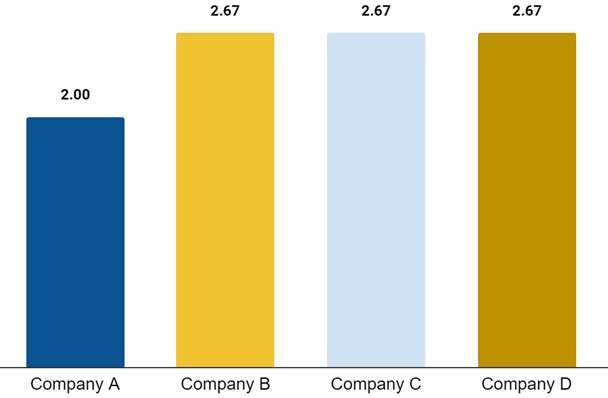
Do you think this kind of diversity hiring policy is unfair to you? (average)
1=Strongly Disagree; 5=Strongly Agree
| Gender | # respondents | AVERAGE of D/A[23] Unfair (A) | AVERAGE of D/A Unfair (B) | AVERAGE of D/A Unfair (C) | AVERAGE of D/A Unfair (D) |
| Transgender | 3 | 3.0 | 2.0 | 1.6 | 2.0 |
| Grand Total | 3 | 3.0 | 2.0 | 1.6 | 2.0 |
- Insight #5
Implementing policies that exclusively hire women leads to losing out on high-performers.
- This is particularly true for high performing men.
- Even high performing women do not prefer exclusive women hiring.
- High performing women have a preference for a fixed quota, and showed a lack of willingness to join company D.
Willingness to Join Score (average)
1=Low; 4=High
# of Respondents = 35 [High-performers]
| Performance Level | Gender | # respondents | Company A | Company B | Company C | Company D |
| High | Man (D>C>B>A) | 15 | 1.6 | 2.0 | 3.1 | 3.3 |
| Woman (B>C>D>A) | 20 | 2.1 | 3.1 | 2. 6 | 2.2 | |
| High Total | 35 | 1.9 | 2.6 | 2.8 | 2.7 |
The preference for C over B for men is much higher than that for men—>high-performing men in particular, are the most sensitive (highly prefers) to a merit based hiring policy
Ratio of ‘Encouragement to Apply’ for C over B[24]
[C-merit, B-fixed quotas]
| Performance Level | Man | Woman |
| High | 1.4 | 1.1 |
| Low | 1.1 | 1.1 |
| Average | 1.2 | 1.0 |
Conclusion
- A diverse and inclusive environment is necessary for the employee satisfaction, retention and productivity of women in the workplace. Diversity begets diversity
- To create this diverse environment, companies must not use methods like exclusively hiring women because that affects the recruiting process.
If your goal is to hire a certain number of women while not losing out of high-performing candidates, your options from best to worst are: C→B→D→A (C would be the optimal choice)
Despite the limited sample size, the study’s main objective was to examine how gender diversity policies affected employee satisfaction, productivity, and retention in the Indian labor market. This narrow focus made it possible to conduct in-depth investigation and analysis within a specific area of study. The results can offer insightful preliminary information and act as a framework for additional study in this field.
It is crucial to recognize that a bigger sample size could improve the study’s statistical power and generalizability. But the distinctive learnings from this smaller sample can provide a qualitative picture of the processes at work. These preliminary results might be supported and expanded upon by more research with a bigger sample, leading to a more thorough grasp of the subject.
Recommendations
Going by the fact that merit-based hiring is the best way to not lose out on high-performing candidates, an effective method to increase the percentage of women in the workplace is to train women before hiring them. Women can be better prepared to compete for jobs previously held by men if the relevant opportunities, skills, and knowledge are given to them.
Eg: Tech field; Encouragement should be given to women to get into STEM courses and participate in related competitions from school-time (an institutional system change)
These are some of the benefits of this strategy:
- Leveling the playing field- The skills gap can be closed and women can be given equal standing when seeking for jobs by preparing them through training programs, thus leveling the playing field.
- Building confidence- Training programs assist women build the confidence they need in addition to giving them the skills they need.
- Reducing Unconscious Biases- Employers can combat these biases by providing women with training opportunities that show women to be just as capable and competent as their male colleagues.
Within the recommendations section, lay out several potential objectives of hiring policy (e.g., attain a certain % of women in your company, maximize % of high performers, etc.) and for each objective, show what a company should do from a D&I policy and procedures perspective to attain it.
Future Scope
The future scope of this research article includes a number of crucial areas for additional investigation and improvement, with the goal of providing a thorough understanding of the variables influencing high-performing women’s preferences in terms of employment choices, particularly in organizations that place a high value on meritocracy and fair hiring practices.They key question is – why do high performing women did not prefer C/D though they focused on merit/unbiasedness in their hiring policy?
By taking into account a bigger sample size and exploring the implications and necessity of Diversity and Inclusion (D&I) policies with reference to promotions, the study also aims to broaden its scope. Additionally, it is to be considered that diversity should go beyond merely gender and be thought of in a larger sense.
[1] Calderón, J. A. R. (2012). Cuando se habla de diversidad ¿de qué se habla? Una respuesta desde el sistema educativo. Revista Interamericana de educación de adultos, 34(1), 76-96.
[2] Hays-Thomas, R. (2022). Managing workplace diversity, equity, and inclusion: A psychological perspective. Routledge.
[3] Crumpacker, M., & Crumpacker, J. M. (2008). The U.S. Federal Senior Executive Service (SES) and Gender Diversity: Would Proposed Legislation Enhancing the Representational Diversity of Selection Panels Necessarily Increase the Number of Female Appointments to the SES? Public Personnel Management, 37(4), 417–433. https://doi.org/10.1177/009102600803700404
[4] Murphy, W. (2018). Distinguishing diversity from inclusion in the workplace: Legal necessity or common sense conclusion? Journal of Business Diversity, 18(4). https://doi.org/10.33423/jbd.v18i4.247
[5] Leone, M. (2020). Diversity and Inclusion in the Workplace; Benefits, Challenges and Strategies for Success. School of Professional Studies. 42 https://commons.clarku.edu/sps_masters_papers/42
[6] Wadhwa, S., & Aggarwal, P. (2023). Study on the impact of diversity and inclusion at workplace. Journal of Management & Public Policy, 14(2), 64–73. https://doi.org/10.47914/jmpp.2022.v14i2.007
[7] Jehn, K. A., Northcraft, G. B., & Neale, M. A. (1999). Why differences make a difference: A field study of diversity, conflict, and performance in workgroups. Administrative Science Quarterly, 44(4), 741–763. https://doi.org/10.2307/2667054
[8] Richard, O. C., Barnett, T., Dwyer, S., & Chadwick, K. (2004). Cultural diversity in management, firm performance, and the moderating role of Entrepreneurial Orientation Dimensions. Academy of Management Journal, 47(2), 255–266. https://doi.org/10.5465/20159576
[9] Gutierrez, S. R. (2023). The Impact of Diversity & Inclusion Policies on Organizational Performance in For-Profit Organizations. https://doi.org/10.15611/2023.33.6.03
[10] Roberson, Q. M. (2019). Managing diversity in organizations. John Wiley & Sons
[11] Kramschuster, A., Blomme, R. J., & Tromp, D. M. (2016). Managing Diversity in Organizations: An Integrative Approach, Hampshire UK. Palgrave Macmillan.
[12] Pelled, L. H., Eisenhardt, K. M., & Xin, K. R. (1999). Exploring the black box: An analysis of work group diversity, conflict, and performance. Administrative Science Quarterly, 44(1), 1–28. https://doi.org/10.2307/2667029
[13] Roberson, Q. M. (2019). Managing diversity in organizations. John Wiley & Sons
[14] Cross, S. E., Bacon, P. L., & Morris, M. L. (2003). The relational‐identity formation model of multicultural competence development. Cultural Diversity and Ethnic Minority Psychology, 9(3), 238-252.
[15] Turi, J. A., Khastoori, S., Sorooshian, S., & Campbell, N. (2022). Diversity impact on organizational performance: Moderating and mediating role of Diversity Beliefs and leadership expertise. PLOS ONE, 17(7). https://doi.org/10.1371/journal.pone.0270813
[16] https://www.ijirt.org/master/publishedpaper/IJIRT159998_PAPER.pdf
[17] Turi, J. A., Khastoori, S., Sorooshian, S., & Campbell, N. (2022). Diversity impact on organizational performance: Moderating and mediating role of Diversity Beliefs and leadership expertise. PLOS ONE, 17(7). https://doi.org/10.1371/journal.pone.0270813
[18] Difference between C & D: C prioritizes hiring candidates solely based on their skills and qualifications, aiming to create a level playing field for all applicants. D on the other hand, has implemented blind hiring practices, where candidate names, genders, and other identifying information are removed from applications to eliminate unconscious biases.
[19] Note: The graph is based on the average score given by the respondents to a company based on their willingness to join , with 1 being the lowest and 4 being the highest.
[20] Note: The graph is based on the average score given by the respondents to a company based on their willingness to join , with 1 being the lowest and 4 being the highest.
[21] D/A is Disagreement/Agreement to the question-Is the policy Unfair to you? So here, 1 stands for the policy being fair and 5 for the policy being unfair.
[22] The graph is based on the average score given by the respondents to a company based on their willingness to join , with 1 being the lowest and 4 being the highest.
[23] D/A is Disagreement/Agreement to the question-Is the policy Unfair to you? So here, 1 stands for the policy being fair and 5 for the policy being unfair.
[24] The table shows the ratio of average of “Encouragement to Apply” of the respondents of company C to company B.


